腫瘍治療電場療法オプチューン
当院では新規脳腫瘍治療システムである「オプチューンⓇ」(交流電場腫瘍治療システム)の処方が可能です。
医療機関のみなさまへ
登録医の先生方、地域の先生方におかれましては、常日頃より当院との連携に多大なご理解を頂き、誠に有り難うございます。この度、新規脳腫瘍治療システムである「オプチューンⓇ」(交流電場腫瘍治療システム)が当院でも処方可能となりましたので、ご紹介させて頂きます。
当院での脳腫瘍への取り組み
脳神経センター(脳血管・神経内科、脳神経外科、脳血管内治療科)で扱う疾患は、脳卒中(脳梗塞・脳出血・くも膜下出血)、外傷、機能的疾患(顔面けいれん、三叉神経痛など)、変性疾患(パーキンソン病など)など多岐にわたります。私ども東部病院脳神経センターでは、ER・救急救命科と連携し脳卒中超急性期や重症頭部外傷を中心に患者さんの治療に当たっております。その一方、脳神経外科では脳腫瘍などの疾患も積極的に受け入れて治療を行っております。
一般的に「脳腫瘍」とは頭部に発生する腫瘍全般を指した総称で、実は多様な腫瘍が含まれます。腫瘍発生の観点からは、①脳実質由来腫瘍(脳組織そのものが腫瘍化したもの)、②脳周囲組織由来腫瘍(周囲組織である髄膜・骨などが腫瘍化したもの)、③転移性脳腫瘍(他臓器悪性腫瘍の転移)に分けることが出来、更にそれぞれ、病理学(組織学)的悪性度(良性・悪性腫瘍)や先天性・後天性など細かく分類されます。実際の治療はCT・MRIなどによる画像診断、腫瘍マーカーなどの検査結果、機能的検査などから対象腫瘍を術前診断して治療計画を立てます。治療は外科的治療(腫瘍摘出)・化学療法・放射線療法を組み合わせです。手術により腫瘍を減じて脳実質の負担を軽減し、病理診断を基に後療法を含めた治療計画を適宜修正して治療にあたります。
脳腫瘍治療において他臓器と大きく異なる点は、血液脳関門の存在により有効な化学療法の種類が非常に限られていることです。その分、外科的治療および放射線療法の比重が非常に大きい領域といえます。以前は最大限に腫瘍摘出・照射を行う事が多かったのですが、近年では、神経機能を悪化させない範囲で可能な限り腫瘍摘出・照射を行う方針となってきています。当院では、神経ナビゲーション・神経モニタリング・蛍光術中診断などを用いて神経機能温存を図る安全確実な手術、化学療法そして強度変調放射線療法(Intensity Modulated Radiation Therapy、IMRT)や定位放射線療法(サイバーナイフ)による神経保護に努める放射線治療により、膠芽腫を初めとした原発性悪性脳腫瘍、肺癌・消化器がんなどからの転移性脳腫瘍、そして髄膜腫や聴神経腫瘍などの良性腫瘍など、ほぼ全ての脳腫瘍の治療を行っております。
膠芽腫(グリオブラストーマ)
上述の様な治療技術や設備により効果の高い脳腫瘍治療を当院では行っておりますが、現在の標準治療では治療効果を十分に得ることが出来ない疾患もあります。その代表が最も悪性度の高い脳実質腫瘍である膠芽腫(グリオブラストーマ)です。標準治療は開頭腫瘍摘出および化学療法(テモゾロミド)+放射線療法(全脳照射)による後療法(約6週間)です。その後もおよそ4週間毎の化学療法(テモゾロミド、Stupp regimenという)を行い、必要に応じて各種治療を追加します。しかしながら、以前よりも延長はしたものの、発症からの平均生存期間は今だ15ヶ月に過ぎず、極めて予後が悪く悪性度が高い疾患です。しかも、上記標準治療が提唱されてから約10年が経過しましたが、現時点でさらなる有効性が示された化学療法・免疫療法などはありません。動物実験ではウィルス、細胞を用いた遺伝子療法(HSVtk、yCD、Toca 511など)が有望視されていますが、実用化にはまだ時間を要すると思われます。
TTフィールド療法(腫瘍治療電場療法)
そのような中、登場したのがイスラエル人医師により開発された電場を用いた治療法です。電場とは、電流や磁気ではなく、電気の周りに帯びている力の場のことで、いわば重力のようなものにたとえられます。オプチューンⓇ(図1)はアレイと呼ばれるセラミックの板が付着した粘着シートを頭部に貼ることにより、Tumor Treating Fields(略してTTフィールド)という低強度の交流電場を脳内に発生させます(図2)。この電場の力が急速に増殖している腫瘍細胞内の微小管に影響を与えて細胞分裂を阻害し、腫瘍細胞が死滅するよう作用します(図3)。電場は、急速に分裂する腫瘍細胞に対して影響を与えますが、ゆっくりと分裂する正常細胞にはほとんど影響を与えません。
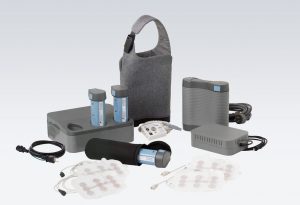
図1)オプチューンⓇ
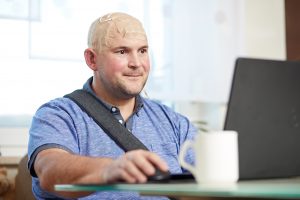
図2)頭部のアレイにてTTフィールドを発生させる

図3)TTフィールドによる殺腫瘍効果
オプチューンⓇは、腫瘍細胞のみを標的とする局所に限定した非侵襲性の治療法で、化学療法などでみられる吐き気、食欲不振、血球数の減少などの全身性の副作用を増大させることのない治療法です。
実際、海外で施行された手術および放射線化学療法後の初発膠芽腫を対象とした臨床試験(EF-14試験)では、「オプチューンⓇとテモゾロミド化学療法併用群」の方が「テモゾロミド化学療法単独群」よりも2年および5年生存率を優位に延長することが示されました(2年43, 31%; 5年13%, 5%)(図4)。オプチューンⓇの併用は腫瘍細胞の成長や再発までの期間を遅らせることができ、標準治療の成績を凌駕し得た現時点で唯一の膠芽腫に対する追加治療なのです。現在、米国NATIONAL COMPREHENSIVE CANCER NETWORKⓇ(NCCNⓇ)の膠芽腫に対する治療ガイドラインでは、オプチューン+テモゾロミド療法がカテゴリー1で推奨されています。
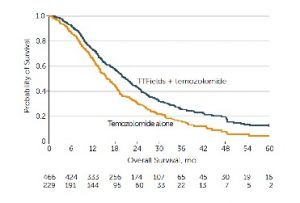
図4)青のグラフ(オプチューン+テモゾロミド療法)の生存率が高い
本邦において、オプチューンは2015年3月に再発膠芽腫に対して、2016年12月には初発膠芽腫に対する薬事承認を得ており、認定講習を受講した医師がおり、一定の条件を満たした医療機関でのみ使用可能です。2017年12月より初発膠芽腫患者に対して保険収載され、患者さんの負担が少なく利用出来るようになっております。本治療法はまだ始まったばかりではありますが、米国では早くも推奨治療となっており、非常に効果的且つ安全なことから膠芽腫の患者さんにとって新しい希望といえます。「最高の医療をこの地域に」との思いから当院でも体制を整備し、2019年1月から本治療法の施行を可能と致しました。神奈川県では当院を含め6施設(北里大学病院、東海大学医学部付属病院、横浜市立大学附属病院、帝京大学医学部附属溝口病院、川崎市立川崎病院)のみで処方可能です。先生方の患者さんに悪性神経膠腫・膠芽腫と診断された、または疑われた方がおられましたら、是非当院までご連絡頂ければ幸いです。宜しくお願い申し上げます。
腫瘍治療電場療法とはどのような治療?
腫瘍治療電場療法による治療をいつ始めるのか
初発膠芽腫(膠芽腫はグリオブラストーマとも呼ばれ、脳内に発生する悪性脳腫瘍です)の場合、可能な限り手術で腫瘍を摘出、術後にテモゾロミドを併用する放射線治療、その後テモゾロミドによる維持化学療法、という標準治療が確立されています。腫瘍治療電場療法はこのテモゾロミドによる維持化学療法を開始するタイミングで始めます(保険診療)。
再発膠芽腫の場合、可能であれば手術や放射線療法、化学療法などを行い、その後腫瘍治療電場療法による治療を開始します。ただし保険適用外で、自由診療となっています。
腫瘍治療電場療法はどのような治療?
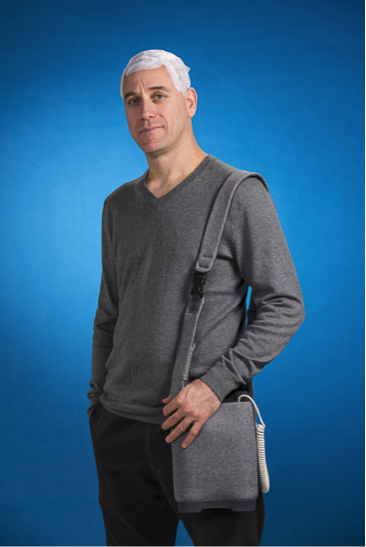 アレイと呼ばれる電極パッド4枚を、頭髪をきれいに剃った頭皮に貼ります。
アレイと呼ばれる電極パッド4枚を、頭髪をきれいに剃った頭皮に貼ります。
アレイと本体を接続し、アレイを介して脳内の腫瘍細胞へ電場を印加することによって、腫瘍細胞の分裂を遅延または停止を促す治療法です。
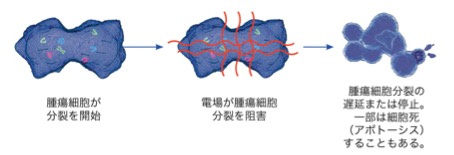
薬と違って電源が入っている間しか治療効果がないので、可能な限りの継続的治療が推奨されます(1日平均18時間以上の使用が目安です)。
頭髪が伸びるとアレイと頭皮の間に空間ができ、それが抵抗となってアレイが正しく機能しなくなるため、アレイ交換の度に頭髪をていねいに剃って、交換する必要があります。個人差がありますが、週2回程度交換します。ひとりでアレイを交換するのは難しいので、家族や友人、訪問看護師等のサポートが必要です。治療の概要については下記の動画を参考にしてください。
治療中のサポート体制は?
機器の使用に関しては、デバイス・サポート・スペシャリスト(DSS)が24時間体制でサポートします。DSSは機器に関する質問に答えたり、何時間治療を行ったか機器に記録されるログを見て、その情報を主治医に提供したりします。
治療を行いながら日常生活を送るには?

治療は自宅で行います。治療しながら日々の仕事や家事を行い、外出や旅行など楽しむことができます。
治療の際は頭髪を丁寧に剃ってアレイと呼ばれる電極パッドを貼りますが、ウィッグ(かつら)や帽子などを着用することが可能です。
アレイを貼付したまま飛行機へ搭乗して移動することができますので、旅行などに行くこともできます。
注意が必要な有害事象
海外で実施された臨床試験で腫瘍治療電場療法がテモゾロミドの副作用を増大する事実はありませんでした。化学療法は薬剤が血流を通して全身に行き渡るため、全身の正常細胞に影響を及ぼしえますが、腫瘍治療電場療法は腫瘍を標的とした局所療法で、脳や全身の正常細胞に影響を与えません。
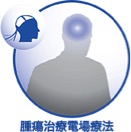 |
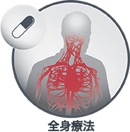 |
|
腫瘍を標的とした局所療法で、脳や全身の正常細胞に影響を与えません。 |
化学療法などの薬剤が血流を通して全身に行き渡るため、全身の正常細胞に影響を及ぼしえます。 |
- 腫瘍治療電場療法の主な副作用は、アレイの貼付箇所の皮膚炎症です。臨床試験では、約半数に皮膚障害があったことが報告されましたが、症状はいずれも軽度から中等度のもので、局所的な対応や治療を一時的に中断することで対処できました。
- まれに頭痛、脱力、転倒、疲労、筋攣縮、皮膚潰瘍が起こることがあります。
出典:ノボキュア株式会社様提供
